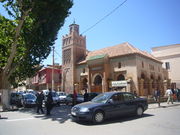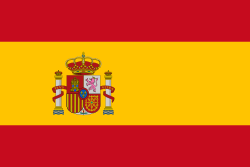Tlemcen
| Tlemcen تلمسان |
|
|---|---|
| — Town — | |
.jpg) |
|
 Tlemcen
|
|
| Coordinates: | |
| Country | |
| Province | Tlemcen |
| District | Tlemcen |
| Area | |
| - Total | 9,061 km2 (3,498.5 sq mi) |
| Elevation | 842 m (2,762 ft) |
| Population (2006) | |
| - Total | 846,942 |
| - Density | 93.5/km2 (242.1/sq mi) |



Tlemcen (Arabic: تلمسان) is a town in Northwestern Algeria, and the capital of the province of the same name. Its population is 132,341 as of the 1998 census. Located inland, it is located in the center of a region known for its olive plantations and vineyards. The city has developed leather, carpet, and textile industries, which it ships to the port of Rashgun for export. The word Tlemcen (Arabic: تلمسان) comes from Berber Tala Imsan (![]() in Tifinagh) which means "the dry spring". The name is sometimes spelled Tlemsen, Tlemsan, or Tilimsen.
in Tifinagh) which means "the dry spring". The name is sometimes spelled Tlemsen, Tlemsan, or Tilimsen.
Contents |
Culture
Its centuries of rich history and culture have made the city a center of a unique blend of music and art. Its textiles and handcrafts, its elegant blend of Arab, Berber, Andalucian and French cultures, and its cool climate in the mountains have made it an important center of tourism in Algeria. It is home to a beautiful tomb - that of Sidi Boumédiène, whose tomb adjoins to a mosque.
History
Tlemcen was founded by the Romans in the 4th century C.E. under the name of Pomaria as a military outpost. It was an important city in North Africa see of the Roman Catholic Church in the century in which it was built, where it was the center of a diocese. Its bishop, Victor, was a prominent representative at the Council of Carthage in 411, and its bishop Honoratus was exiled in 484 by the Vandal king Huneric for denying Arianism. It was a center of a large Christian population for many centuries after the city's Arab conquest in 708. In the later eighth century and the ninth century, the city became a Kingdom of Banu Ifran of the Kharijite sufri[1]. In 1082 the Almoravid leader Yusuf ibn Tashfin founded the city of Tagrart, which merged with the settlement and since then became known as Tlemcen (Tilimsan). Under the reign of the Almohads it rose to prominence as a major trading center in the region. It was lost by the Almohads to the Abdalwadid dynasty in 1239.
In the next period Tlemcen became the capital of the (Ziyyanid) kingdom of Tlemcen (1236 - 1554) and was ruled for centuries by successive Abdalwadid sultans. Its flag was a white crescent pointing upwards on a blue field. The city was under the rule of the Marinid sultan, Abu al-Hasan Ali (1337–48). When the Spanish took the city of Oran from the kingdom in 1509, continuous pressure from the Berbers prompted the Spanish to attempt a counterattack against the city of Tlemcen (1543), which was deemed by the Papacy to be a crusade. The Spanish failed to take the city in the first attack, although the strategic vulnerability of Tlemcen caused the kingdom's weight to shift toward the safer and more heavily fortified corsair base at Algiers.
The ruler of Tlemcen is reported to have been advised by a Jewish viceroy named Abraham, who, in the time of the Inquisition of Torquemada, opened the gates of Tlemcen to hordes of Jews and Moors fleeing Spain. Abraham is said to have supported them with his own money and with the tolerance of the king of Tlemcen.
In 1553, the kingdom of Tlemcen came under the protection of the Ottoman Empire, which was fighting a naval war against the Spaniards across the Mediterranean, and the Kingdom of Tlemcen became another vassal of the Sultan in Constantinople. Tlemcen and the Algerian provinces gained effective independence in their own affairs in 1671 , although Tlemcen was no longer the seat of government that it once was (transferred to ?Algiers), and its grandeur was much reduced from the days of its great kings. The Spanish were evicted from Oran in 1792, but thirty years later they were replaced by the French, who seized Algiers. A French fleet bombarded Algiers in 1830, at which point the dey capitulated to French colonial rule; a broad coalition of natives continued to resist, coordinated loosely at Tlemcen. The great Berber leader Abd al-Kader, fought with incredible skill and valor, but his defeat in 1844 at Isly ended the dream of a new independent Algeria.
Tlemcen was a vacation spot and retreat for French settlers in Algeria, who found it to be far more temperate than Oran or Algiers. The city adapted and became more cosmopolitan, with a unique outlook on art and culture, and its architecture and urban life evolved to accommodate this new sense. In the independence movements of the mid-twentieth century, it was relatively quiet, reflecting the city's sense of aloofness from the turbulence of Algiers.
Transport
It is served by the international Zenata airport.
International relations
Twin towns - Sister cities
Tlemcen is twinned with:
 Sarajevo in Bosnia and Herzegovina (since 1964) [2]
Sarajevo in Bosnia and Herzegovina (since 1964) [2] Granada in Spain
Granada in Spain Kairouan in Tunisia
Kairouan in Tunisia Fès in Morocco (since 11 July 1989)
Fès in Morocco (since 11 July 1989) Nanterre in France
Nanterre in France Montpellier in France
Montpellier in France
See also
- Great Mosque of Tlemcen
- Tlemcen Province
- WA Tlemcen
- Tlemcen National Park
References
- Notes
- ↑ Ibn Khaldun, History of Berber
- ↑ "Fraternity cities on Sarajevo Official Web Site". © City of Sarajevo 2001-2008. http://www.sarajevo.ba/en/stream.php?kat=147. Retrieved 2008-11-09.
External links
- Tlemcen, non official website
- Culture, art and history of Tlemcen
- Abou Bakr Belkaid University of Tlemcen
- Wilaya de Tlemcen par Paysage d'Algérie : History and ancient photos.
- membres.lycos.fr/tlemcen13000
- www.netlemcen.fr.st
- Free/Open Source Community of Tlemcen
- Unofficial portrait of this city
 "Pomaria". Catholic Encyclopedia. New York: Robert Appleton Company. 1913.
"Pomaria". Catholic Encyclopedia. New York: Robert Appleton Company. 1913.
|
|||||||
|
|||||||